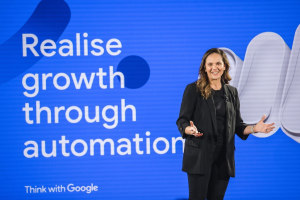
Marketing automation, powered by machine learning, enables brands to reach people wherever they are in their omnichannel consumer journeys. But not only that; it delivers relevant creative while using less granular data to provide user privacy, and - importantly - optimises performance and drives profits.
“Marketing, as we know, is all about making meaningful connections with consumers,” says Jim Lecinski, Clinical Associate Professor of Marketing at Northwestern University’s Kellogg School of Management in a recent conversation with Mel Silva, MD & VP of Google AUNZ. “Machine learning has taken hold in various different aspects of the firm… but marketing has been among the slower functions in the firm to adopt the power of automation.”
So, why is it essential to switch on machine learning in your marketing now?
First, consumer journeys are long, they’re complex, they’re messy, and they’re increasingly digital - this, we know. There has been sustained growth in online shopping since before the pandemic, and in Australia, over 80% of under 55s shop online[1].
Second, people are curious. They ask more questions and search across platforms, and 91% of Australians interact with brands on at least 2 different channels before making a purchase decision[2]. They value relevance from brands, and with 15% of Google Search queries every day being entirely new[3], that’s no small ask.
When this is the playing field, the only way to reach and delight thousands, or even hundreds of thousands of disparate individual customers is to automate.
While the possibilities are nearly limitless, there are three main ways automation can help brands.
First, by helping you show up with the right message, at the right time, and in the right place. Machine learning algorithms are excellent at testing and learning on your behalf, then scaling the best creative combinations to where they can be most effective.
Second, by helping you connect with high value customers at scale. Automation can help paint a picture of what your high value customers look like, then go out and find more of those people from right across the web - helping to drive more revenue at lower cost, and boost profitability.
And third, automation can help you simplify campaign management by drastically cutting the manual admin required to organise and optimise your campaigns - freeing you up to spend time on finer marketing skills like strategy and messaging.
So with such clear benefit, what’s holding marketers back? “I think there’s a common misperception that the machines will just take over or somehow take all of our jobs,” says Jim, who recently authored the book, The AI Marketing Canvas, “When in reality it’s quite the
opposite. You’re a marketer who uses your knowledge of the customer, your human ingenuity, your insights, your creativity and, importantly, the business and marketing objectives that you set. That's what the machine will then go and automate. So you retain control, as opposed to cede control. It's the algorithm that's in service of the marketer when you incorporate automation and not the other way around.”
In fact, it’s quite an extraordinary time to be a marketer, to be able to experiment en masse and combine human and technological intelligence in this way. In very real terms, marketers are pioneering new technologies and ways of doing things that will lay the foundation for years to come.
It’s easy to feel overwhelmed by the global powerhouses who are already doing incredibly advanced things in this space, but Jim has an answer for that. “It’s not too late to be early, so don’t worry that you’ve missed the boat on this one,” he says. “The way to get started is to find a business problem that, by being able to predict the outcome, would unlock extreme incremental value for your business. Once you’ve identified that business problem more often than not a marketing team would be working with an existing marketing partner.”
Modern marketing means automation. And in a privacy-first future, an automated approach will be absolutely essential to ensuring your brand is able to continue showing up along complex paths to purchase.
But it won’t just magically appear in your business. It’s integrated over time, and in stages. So get started, reach out to your marketing partners, and begin your journey towards realising growth through automation.
Watch the full conversation between Mel and Jim now on Think with Google
[1]Source: Google/ Kantar, Shopper Pulse Australia, April to December 2021, 18-55yrs, n=3,482.
[2]Google / GfK, Continous Connection Study, Australia, Qual / Quant study of n=300 aged 18+ category shoppers (n=150 of whom were passively metered) over a month in Mar-Apr'21. Base: respondents compliant for passive & 5+ moments surveys n=97
[3]Google Internal Data
Have something to say on this? Share your views in the comments section below. Or if you have a news story or tip-off, drop us a line at adnews@yaffa.com.au
Sign up to the AdNews newsletter, like us on Facebook or follow us on Twitter for breaking stories and campaigns throughout the day.

